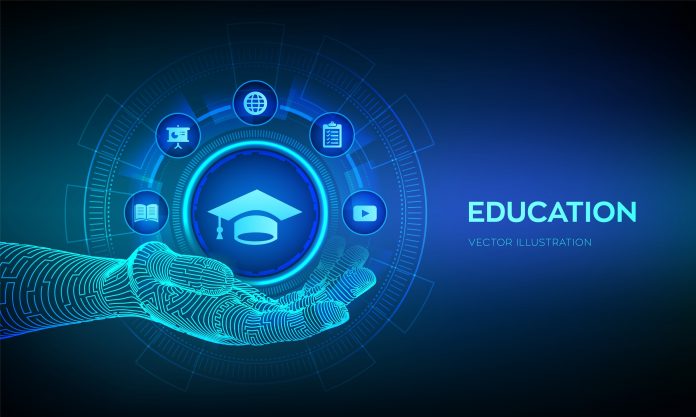Karl Deady, Executive Director at Cinos, talks about the role of AV & IT across the higher education space and the steps that organisations can put in place to positively impact the learning experience for students
As the student user experience becomes more important than ever, so does the role of audio-visual (AV) technology. The coronavirus pandemic has led to the closure of many university campuses and AV and IT solutions hold a vital role in ensuring students and staff remain safe on campus and provide flexibility in a time when the sector needs it most.
Creating the ideal learning space
Like many working environments, it’s often the small changes that go a long way to improving the overall experience. When it comes to learning, the key to success is ensuring spaces inspire and create an engaging experience.
In order for students to be fully absorbed, they need to be able to see the content and hear the educator loud and clear. Universities and educational institutions can ensure this by implementing high-quality display technology and professional-grade audio products. If students can’t view the content properly or hear the educator, there’s a risk they’ll lose interest and engagement levels will drop.
When it comes to teaching, educators can engage with students in many ways whether that’s a live lecture, streamed or even on-demand. It is important to offer multiple ways for students to consume course content and offering choice will only enhance the learning experience. Whatever the choice, the systems must be easy to use for both educators and students. There’s nothing worse than a system that’s complicated and frustrating to navigate. Using feature-rich collaboration workspaces such as Microsoft Teams gives the ability to interact with students through chat, voice and video. Sessions can be recorded and learning resources shared through the platform’s secure file sharing functionality. This is a great tool for students, helping them access the necessary information on demand.
Creating efficient processes for the long term
Within a learning space there are a number of considerations that need to be made when choosing video and audio solutions. It’s best to look for technologies that offer flexibility and AV devices that leverage the existing IT network (AV/IP) are a great way to achieve this. They are easier to scale when compared to traditional analogue systems. It means that you do not need to convert signal format across devices, reducing the complexity and costs considerably. This allows educators to push video or audio signals to multiple learning spaces or even directly into the students’ homes, helping to increase efficiency in the long run. Furthermore, AV/IP solutions can help organisations comply with social distancing guidelines. By delivering content across multiple lecture theatres and integrating into campus-wide streaming services the number of students in each physical space is greatly reduced.
To maximise return on investment institutions should work with an integrator who truly understands the technology that will make a difference. Audio and visual technologies need to be reliable and stand the test of time, so look to robust solutions that can be easily maintained by onsite support teams.
Bring your own device (BYOD) is a useful service that should be made available to the wider student population, as it allows students to consume course contents at their leisure and on their own devices. Not only is this particularly useful for students moving around campus between sessions, but it also ensures the content is easily available for students who cannot physically attend the session, for example, where self-isolation is required.
As with any organisation, minimising the impact on the environment and reducing carbon footprint is key. This can be achieved by implementing energy-efficient recyclable products and employing technologies such as motion sensors that can automatically shut down or start up classroom equipment, lighting and heating, ventilation and air conditioning (HVAC). In a similar vein, having a resource management system in place can provide insights on room and equipment utilisation allowing educational institutions to adapt their practices accordingly.
Unified communications to maximise learning experience
As we’ve seen with the challenges brought on by the coronavirus pandemic, it’s key to have future proof systems in place, especially ones that enable remote learning. Choose video conferencing solutions that are familiar, easy to use, robust and well built. Platforms like Zoom, Microsoft Teams and Webex all have the capabilities to facilitate virtual learning sessions.
Through the installation of plugins, these solutions can integrate with virtual learning environments (VLEs) such as Blackboard and Moodle, allowing the student to move seamlessly from video collaboration to accessing learning resources via their learning platform. Integrators are best placed to provide onsite support for institutions and advice around on-going costs, both in terms of licencing and maintenance. This can help education institutions to budget effectively and choose the best option based on their needs.
Remote learning capabilities are more important than ever. Having tools like Zoom or Microsoft Teams in place can help universities to promote seamless collaboration and minimise some of the disruption caused for students by these very uncertain times. While the etiquettes of conferencing calling won’t be unfamiliar to educators, they might very well be to students. Familiarising students with remote learning practices is really important to ensure sessions remain productive and engaging for all. Steps such as muting when not talking and preventing all attendees from talking at the same time must be made clear from the start.
AV to solve the campus crisis
Higher education has had to overcome many challenges in recent months, from social distancing to safely navigating the return to campus learning. AV technology has a part to play in helping bring confidence to universities as they go about creating processes that are safe for both staff and students. For those who are learning onsite, AV also has a role to play in helping implement social distancing guidelines. Desk booking systems can be deployed to ensure the correct social distancing measures are in place throughout lecture halls and learning spaces.
As education institutions look to next year and plan to reopen campuses, they need to ensure their spaces are flexible for new ways of working and educating. Adopting technology that can adapt to the changing demands is key for the sector to thrive.











